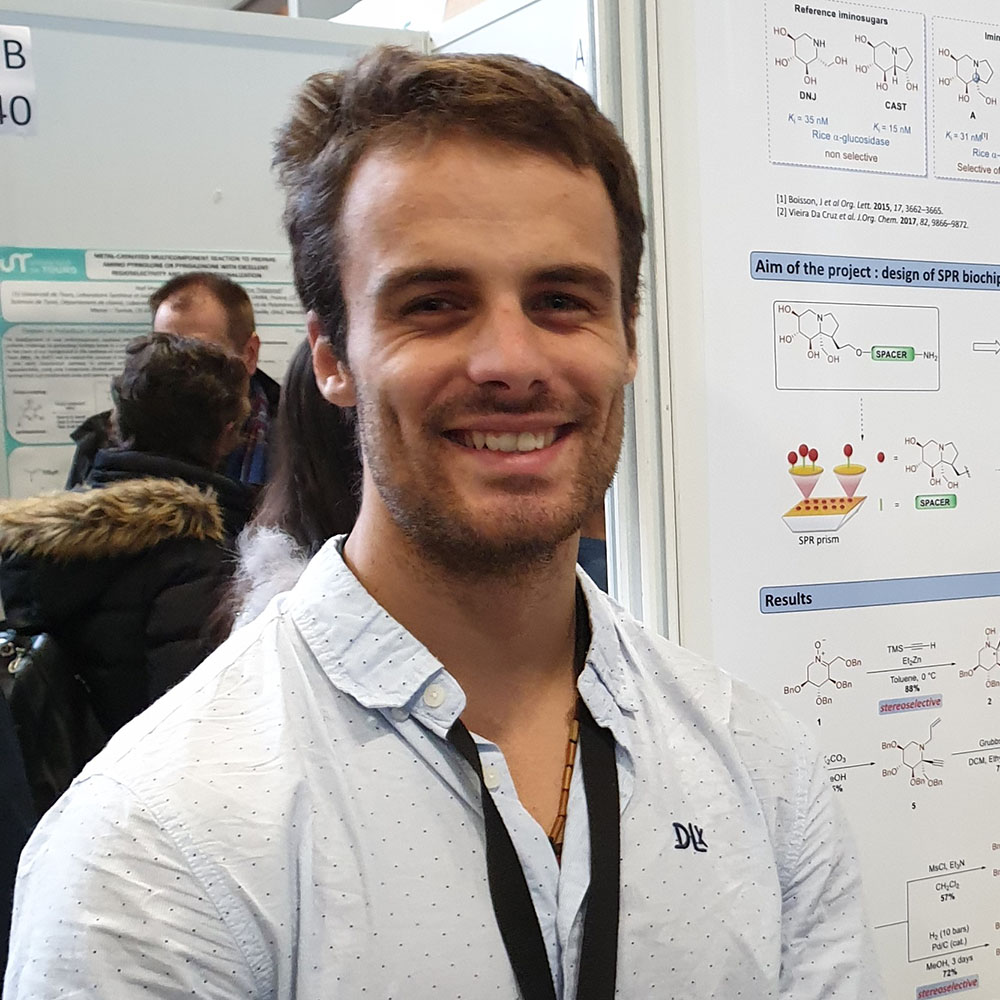- Share
- Share on Facebook
- Share on X
- Share on LinkedIn
The ARCANE labex brings together all of Grenoble's research laboratories for which molecular chemistry constitutes the heart of their research activity. As such, and by its multi-supervisory nature, it is a key element of local coordination in chemistry training. The calls for projects are addressed to the 7 labex laboratories. One of the main selection criteria is the synergy effect that an inter-laboratory collaboration can bring. The listed projects are fully or partially funded by the ARCANE labex.

Matteo Ecolasse
Microneedles functionalized with aptamers for the optical detection of cortisol
The goal of this subject is to develop a biosensing device using microneedles and aptamers to measure cortisol. That device would offer a reliable way to diagnose cortisol related medical conditions.

Samer Krayan
ElectroPeps: Metallopeptide-based Electrocatalysts for Fuel Synthesis
My work focuses on developing metallopeptide-based electrocatalysts capable of converting waste-derived nitrite into ammonia, offering a sustainable approach to generating valuable chemical resources.
Juliette Alves
Anisotropically stretchable hydrogels with adhesive properties for wound dressing
The aim is to create a hydrogel that can stretch anisotropically and stick to human tissue. In the end, it could replace chirurgical sutures and staples on moving organs and tissues like muscles.

Ankan Nath
DNP-enhanced NMR to improve the stability of lead-free perovskite nanocrystals capped with bio-inspired ligands for the photoelectrocatalytic CO2 reduction
Perovskite nanocrystals, although very useful, need to be stabilized by bio-inspired organic ligands. We want to study this stabilization mechanism using DNP-enhanced NMR spectroscopy.

Cécile Dupont
Synthesis of Polyphenols and their evaluation as inhibitors of Tau fibrillation.
The aim is both the synthesis of polyphenols with a pyrogallol motif and their evaluation using a novel fluorescence polarisation assay.

Léa Latour
Exploring Protein Glycosylation via Targeted Chemical Tagging of methionine residues
Protein glycosylation is one of the major post-translational modifications, with significant effects on protein folding, conformation, distribution, stability and activity.

Preslav Smits
Aldehydes as powerful photoactivated reductants under bio-inspired organocatalysis
In my research, I aim to develop the use of aldehydes - abundant and biosourcable organic synthons, as an alternative to metals as powerful reducing agents.

Mattéo Favre
Iron catalysis for sustainable artificial transaminase-like borrowing hydrogen
Development of transamination reactions using borrowing hydrogen methodologies for a greener synthesis of amines and alcohols.

Claire Bourguignon
Designing robust and efficient molecular photocathodes for solar fuel production
I am working on designing new robust molecular dyes to improve the efficiency of photocathodes for solar fuel production.

Mathis Gunther
Copper-based molecular electrocatalyst for strong C-H bond activation
My thesis subject is about to make new electrocatalyst with copper to replace the actual catalyst made with precious metal.

Majd Khalife
Peptide decorated amyloid fibrils and hydrogels as biomimetic olfactory cilia for sensitivity improvement of electronic nose

Lucie Pastewski
Fabrication of bioelectrocatalytic thin films by layer-by-layer assembly of redox biopolymers and metalloenzymes
Constructing new catalytic films to enhance enzymatic reactions thanks to a biosourced and electron-conducting matrix

Pauline Chevalier
Design of a kit for specific quantification of microorganisms thanks to aptamers and chemiluminescent measurement
Rapid kit which detects a pathogenic Escherichia coli strain with aptamers and then quantify them through ATP measurement.

Adam Nhari
Carbazole-based luminescent lanthanide bioprobes for reactive oxygen species sensing in live cells
My work is to improve and develop responsive probes based on an Eu3+ complex featuring a carbazole antenna imaging agent.

Omar El-Dahshan
Synthesis and advanced characterization of stable Ag2S quantum dots for in vivo imaging
Synthesis, surface-functionalisation and in-vitro stability of new non-toxic quantum dots as novel biomedical probes for theranostic applications.

Subash Arjunan
Theoretical study of CO2reduction mechanism catalyzed Ni-Fe complex on graphite
My work is on the theoretical study of the reduction mechanism of CO2catalyzed by Ni-Fe complex on graphite layer.

Letícia M. Lazinski
Synthesis of Hemiindigoids as Photoswitchable Entities: a Spatiotemporal Handling of Inhibition for Tyrosinase
Synthesis of hemiindigos (HI) and hemithioindigos (HTI) able to selectively engage human tyrosinase upon photoisomerization under visible light.

Rim Karkori
New fluorogenic reaction induced by a supramolecular assembly of aptamers for the detection of small molecules
Development of a new detection method for small analytes involving aptamers and the formation of fluorescent indolizines via a DNA-templated 1,3-dipolar cycloaddition.

Jade Arnone
Thiol-ene/Oxidation Tandem reaction by HEterogeneous artificial Metalloenzymes
My project is to develop a new reactivity by combining catalytic systems to make selective sulfoxidation synthesis.

Umberto CONTALDO
In vitro biological water-gas shift reaction: Bio-functionalization of carbon nanotubes with carbon monoxide dehydrogenase (CODH) and [NiFe]-hydrogenase
To find alternative to syngas upgrade, our approach is the development of enzymatic water-gas shift reaction via the immobilisation of CODH and [NiFe]-hydrogenase on carbon-nanotubes.

Pierre RIEBER
Development of combinatorial encoded chemistry for the identification of specific ligands of G-quadruplex DNA structures
Synthesis of an unprecedented scale of small molecules to identify biologically active compounds targeting G-quadruplexe, a DNA secondary structure.

Nicolas DAVEAU
HYBRID PLASMONIC NANO-ARCHITECTURES ASSEMBLED BY DNA
Assembly of a Gold Nano Rod with Quantum Dots using DNA to create a new versatile and multi-modal biomarker.

Jordan COSSU
Design, synthesis and characterization of monoclonal antibody mimics
Design of small antibody mimics of the Rituximab using a fully synthetic approach combining aptamers and peptides.

Jérémy CABURET
Rational conception and synthesis of new antibiotics targeting NDM-1 protein
This multidisciplinary project aims to rationally design inhibitors of NDM-1, an enzyme responsible for bacterial resistance by β-lactam antibiotic hydrolysis.

Auriane GUITTON-AUBERTY
Covalent Crosslinks Aptamers-Targets
We propose a new approach to improve the selectivity of aptamers: to form covalent crosslinks between them and their target molecule.

Bastien DARMAU
Integrated Bioelectrodes/Biopolymer-Microneedle Devices for Transdermal Electrochemical Sensing
In this project, we propose to combine enzymatic electrochemical biosensor technology with biopolymer-microneedle sampling for rapid metabolite detection for medical applications.

Damien MOUCHEL
Synthesis of contrast agents for medical imaging
Synthesis of redox active complexes as contrast agents for the detection of reactive oxygen species.

Marie GAILLARD
Development of a microfluidic device for the bio-targeted sorting of extracellular vesicles
Liquid biopsy appears like a promising way for the early detection of cancers. The PhD project aims to the development of a microfluidic device for the bio-targeting sorting of extracellular vesicles.

Paul RIVOLLIER
Production by a chemo-biotechnological approach of synthetic glycolipids toward novel lipid nanoparticles (Glypidots)
Development of biomimetic and stealth nanoparticles for biomedical applications. As a proof of concept, Glypidots will be assessed for their ability to inhibit Influenza virus infection.

Thibault RANCON
Synthesis of new iminosugars as inhibitors and selective probes for alpha-glucosidases
Synthesis of new glycomimetics able to selectively recognize alpha glucosidases (enzymes) in complexe biological media.

Anthonin MOINEL
Developing novel push-pull organic dyes and dye-catalyst assemblies for hydrogen production in dye-sensitized NiO photocathodes
My work consists in designing molecular structures capable of producing hydrogen from water using sunlight as sole energy source.

Ons DAKHLAOUI
Improving selective DNP (SelDNP) for the study of protein binding sites
SelDNP enhanced solid-state NMR is a targeted DNP methodology that aims to recover site-specific information in the vicinity of the paramagnetic moieties to decipher proteins binding sites at high resolution.
- Share
- Share on Facebook
- Share on X
- Share on LinkedIn